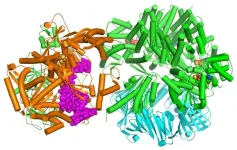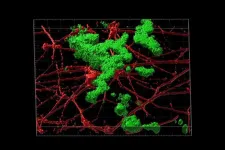(Press-News.org) Andean tropical glaciers are experiencing unprecedented retreat, according to a new study that reveals their current sizes are the smallest in over 11,700 years. “Our finding … identifies this region as a hot spot in our understanding of the changing state of the cryosphere,” say the authors. Glaciers act as important indicators of climate change, with their global retreat accelerating over recent decades. Examining this retreat in the context of the previous 11,700 years of the Holocene interglacial highlights the impact of modern global warming. Although many glaciers worldwide are smaller today compared to their sizes over the Holocene, it’s recognized that glaciers generally retreated to their smallest extents during the early to mid-Holocene. But today tropical glaciers are experiencing unprecedented retreat, possibly due to factors including increasing temperatures at high altitudes. The Andes – home to over 99% of tropical glaciers – are particularly affected, and may be the first to show significant impacts of human-induced climate change on a regional scale. To determine whether the magnitude of tropical glacier retreat in the Andes today exceeds the bounds of Holocene fluctuations, Andrew Gorin and colleagues analyzed paired cosmogenic carbon-14 (14C) and beryllium-10 (10Be) measurements in 20 bedrock samples collected near the margins of four tropical Andean glaciers. Cosmogenic nucleotide measurements can be used to estimate how long bedrock has been exposed, such as due to loss of overlying ice. Gorin et al. discovered that most bedrock samples had near-zero 14C and 10Be concentrations, suggesting that these locations were covered by ice throughout the Holocene and have only recently been exposed. Thus, the adjacent glaciers are likely smaller now than they have been at any point in the past 11,700 years. “Paired with a similar result in the Arctic, the early emergence of these small, fast-responding glaciers from their Holocene baseline may serve as a ‘canary in the coal mine,’ signaling an approaching contraction of higher-latitude glaciers beyond their interglacial range,” write Gorin and colleagues.
END
Current Andean glacier loss is unprecedented in the Holocene
2024-08-01
ELSE PRESS RELEASES FROM THIS DATE:
New fossil resembling a bristly durian fruit reveals insights into the origin of molluscan skeletons
2024-08-01
The early evolution of mollusks has been hard to pin down, but now a newly discovered fossil – of a shell-less, soft-bodied, spiny mollusk from the early Cambrian – provides crucial insights, researchers report. The findings suggest that this fossil, of a creature called Shishania aculeata, is a stem mollusk – representative of an intermediate between early members of the superphylum lophotrochozoans and more derived mollusks. Mollusks are one of the most diverse groups of animals, encompassing various well-known forms such as clams, ...
CLEAR: a new approach to 3D printing materials with highly entangled polymer networks
2024-08-01
Researchers have developed a novel approach to three-dimensional (3D) printing they call “CLEAR,” which significantly improves the strength and durability of materials by using a combination of light and dark chemical reactions to create densely entangled polymer chains. The authors used their approach to print structures with special features, such as the ability to adhere to wet tissues. Incorporation of polymer chain entanglements as reinforcements within 3D printed materials can significantly enhance their mechanical properties. However, traditional vat photopolymerization-based 3D printing techniques, such as digital ...
Genetic insights into how prickles develop across different plants, despite evolutionary separation
2024-08-01
The evolutionary gain and loss of plant prickles – sharp pointed epidermal outgrowths – are controlled by a shared genetic program involving cytokinin biosynthesis, researchers report. The study sheds light on the genetic basis of the emergence of similar traits in distantly related organisms and reveals genomic targets for prickle removal for crop improvement. The genetic basis of trait convergence is a central question in evolutionary biology, and the extent to which it is driven by ...
Climate anomalies may play a major role in driving cholera pandemics
2024-08-01
New research suggests that an El Niño event may have aided the establishment and spread of a novel cholera strain during an early 20th-century pandemic, supporting the idea that climate anomalies could create opportunities for the emergence of new cholera strains. Xavier Rodo of Instituto de Salud Global de Barcelona, Spain, and colleagues present these findings in the open-access journal PLOS Neglected Tropical Diseases.
Since 1961, more than 1 million people worldwide have died in an ongoing cholera pandemic, the seventh cholera ...
Study shows link between asymmetric polar ice sheet evolution and global climate
2024-08-01
Recent joint research led by Professor AN Zhisheng from the Institute of Earth Environment of the Chinese Academy of Sciences has revealed the pivotal role of the growth of the Antarctic ice sheet and associated Southern Hemisphere sea ice expansion in triggering the mid-Pleistocene climate transition (MPT). It has also shown how asymmetric polar ice sheet evolution affects global climate.
The MPT refers to a shift in Earth’s climate system between about ~1.25–0.7 million years ago, marking a shift to more pronounced and regular ...
When it comes to DNA replication, humans and baker’s yeast are more alike than different
2024-08-01
GRAND RAPIDS, Mich. (Aug. 1, 2024) — Humans and baker’s yeast have more in common than meets the eye, including an important mechanism that helps ensure DNA is copied correctly, reports a pair of studies published in the journals Science and Proceedings of the National Academy of Sciences.
The findings visualize for the first time a molecular complex — called CTF18-RFC in humans and Ctf18-RFC in yeast — that loads a “clamp” onto DNA to keep parts of the replication machinery from falling off the DNA strand.
It is the latest discovery from longtime collaborators Huilin Li, Ph.D., of Van Andel Institute, ...
Aging-related genomic culprit found in Alzheimer’s disease
2024-08-01
Researchers at Washington University School of Medicine in St. Louis have developed a way to capture the effects of aging in the development of Alzheimer’s disease. They have devised a method to study aged neurons in the lab without a brain biopsy, an advancement that could contribute to a better understanding of the disease and new treatment strategies.
The scientists transformed skin cells taken from patients with late-onset Alzheimer’s disease into brain cells called neurons. Late-onset Alzheimer’s ...
Andean glaciers have retreated to lowest levels in 11,700 years, news study finds
2024-08-01
Chestnut Hill, Mass (8/1/2024) – Rocks recently exposed to the sky after being covered with prehistoric ice show that tropical glaciers have shrunk to their smallest size in more than 11,700 years, revealing the tropics have already warmed past limits last seen earlier in the Holocene age, researchers from Boston College report today in the journal Science.
Scientists have predicted glaciers would melt, or retreat, as temperatures warm in the tropics – those regions bordering the Earth’s ...
States consider new science-backed solution to save time and money on concrete infrastructure repair
2024-08-01
WEST LAFAYETTE, Ind. — A Purdue University invention that may shorten construction timelines and increase long-term durability of concrete highways, bridges and other transportation infrastructure is emerging as a viable alternative to methods that have been used for decades to estimate when newly poured concrete is mature enough to withstand heavy loads such as those from trucks and other vehicles.
The American Association of State Highway and Transportation Officials’ Committee on Materials and Pavements (AASHTO COMP) has approved the Purdue-developed method as a new national ...
New England Journal of Medicine letter shows plant protein beats animal protein
2024-08-01
BOSTON—Plant-based proteins have major health advantages over animal-based proteins, according to a New England Journal of Medicine letter to the editor by Neal D. Barnard, MD, published Aug. 1, 2024. New findings show that all plants contain all essential amino acids, in contrast to the common but mistaken belief that plants lack one or more amino acids. Of the 20 amino acids that are the building blocks of protein, nine cannot be produced by the human body. All are found in plant sources.
“In addition, plant-based ...





